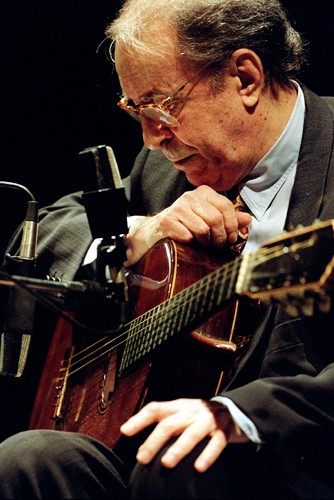Bossa nova, a genre synonymous with sun-kissed beaches and breezy sophistication, emerged as a significant cultural phenomenon in Brazil and quickly captivated the world. But What Is Bossa Nova beyond a catchy tune? It’s a musical style that reflects a specific moment in Brazilian history, a fusion of samba and jazz, and a testament to the power of cultural exchange.

João Gilberto, a pivotal figure in bossa nova, revolutionized guitar playing. His collaboration with Antonio Carlos Jobim resulted in iconic songs. “The Girl from Ipanema,” remains a timeless bossa nova classic.
The Birth of a “New Wave”
The term “bossa nova” literally translates to “new wave” or “new trend,” aptly describing its innovative approach to Brazilian music. Originating in 1956 within the vibrant Copacabana neighborhood of Rio de Janeiro, it was more than just music; it was a reflection of a burgeoning sense of optimism and national pride. As Chico Buarque, a renowned Brazilian musician, described, bossa nova flourished alongside other artistic movements like Cinema Novo and the architecture of Oscar Niemeyer, all contributing to a feeling of euphoria and national identity.
Bossa nova was essentially a sophisticated blend of samba, Brazil’s traditional music, and cool jazz, a popular genre in the United States. This fusion appealed to the Carioca middle class, who frequented jazz clubs and were increasingly exposed to North American culture. Juscelino Kubitschek’s presidency further fueled the movement by promoting economic growth and reducing state control over the music industry, allowing for greater creative expression and wider distribution. Lyrically, bossa nova often celebrated the beauty of the musicians’ surroundings: the beaches, the flowers, the clear blue skies, and the captivating women of Rio.
Bossa Nova’s Cultural Exchange and Global Appeal
While some critics initially dismissed bossa nova as a mere imitation of American cool jazz, figures like Antônio Carlos Jobim strongly refuted this claim, asserting that bossa nova profoundly influenced North American music. This influence is undeniable, as American musicians were captivated by its distinctive rhythms, lush instrumentation, and themes of youthful exuberance.
American guitarist Charlie Byrd’s visit to Brazil in the early 1960s, sponsored by the State Department, marked a turning point. Upon returning, he collaborated with saxophonist Stan Getz, resulting in a landmark album that introduced bossa nova to a wider American audience. This collaboration paved the way for further partnerships between American and Brazilian musicians, including Jobim, Gilberto, and Luiz Bonfá, whose work on the film Black Orpheus brought bossa nova to international acclaim.
“The Girl from Ipanema” became a global phenomenon, winning a Grammy Award and being recorded in both English and Portuguese by countless artists. It exposed audiences worldwide to the richness and complexity of Brazilian music, though some argue that its overexposure eventually led to its association with generic cocktail-lounge music. The song’s undeniable catchiness and simple beauty made it a global earworm.
The Evolution of Bossa Nova: Politics and Musical Transformation
As the initial euphoria of the late 1950s and early 1960s faded, Brazil faced economic challenges and growing social inequalities. This led to debates within the popular music culture. A wave of Brazilian nationalism emerged, questioning the capitalist model and criticizing bossa nova for its perceived detachment from cultural traditions and the struggles of the nation’s poor.
Zé Keti, prominent samba singer of the “samba de morro” movement, gained renewed popularity in the 1960s, symbolizing the shift towards incorporating diverse Brazilian musical traditions.
Increasingly critical university students and youth saw bossa nova as lacking class consciousness and aligned with a capitalist vision of modernization. The purpose of an apolitical art form was questioned, and a call for explicitly leftist creative expression arose as an alternative to the state’s message.
This shift led to the emergence of protest songs and musical styles like Música Popular Brasileira (MPB) and Tropicália, which incorporated urban and rural musical traditions, such as marcha, berimbau, and samba de roda. While bossa nova continued to be popular internationally, within Brazil, these new forms gained prominence by consciously integrating elements of Brazilian folk music, popular traditions, and even North American rock ‘n’ roll. Artists like Zé Keti, from the samba de morro movement, and Nara Leão, a former bossa nova musician, gained renewed popularity by addressing social injustice and racial inequality in their work.
The Lasting Legacy of Bossa Nova
Despite evolving musical landscapes and political shifts, bossa nova’s influence remains undeniable. It remains a significant genre in the history of Brazilian music, demonstrating a unique cultural exchange and leaving behind timeless songs that continue to be enjoyed worldwide. Exploring what is bossa nova reveals not only a captivating musical style but also a complex story of national identity, artistic innovation, and the evolving relationship between music and society.
Further Reading:
- Ruy Castro’s Bossa Nova: The Story of the Brazilian Music That Seduced the World offers an in-depth history of the movement based on interviews with its key figures.
Sources:
- Leite, Geraldo. “Semana Chico Buarque.” Radio Eldorado, 27 September 1989.
- McCann, Bryan. Hello, Hello Brazil: Popular Music in the Making of Modern Brazil. Durham: Duke University Press, 2004.
- McGowan, Chris and Ricardo Pessanha. The Brazilian Sound: Samba, Bossa Nova, and the Popular Music of Brazil. Philadelphia: Temple University Press, 2009.
- Treece, D. “Guns and Roses: Bossa Nova and Brazil’s Music of Popular Protest, 1958-68.” Popular Music-Cambridge 16:1 (1997).